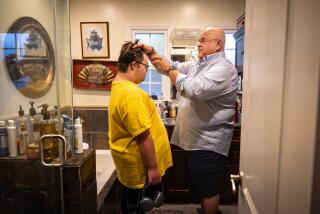âThere Are Days at the Center That Haunt Meâ
Dr. Astrid H. Heger is executive director of the Los Angeles County-USC Violence Intervention Program, which includes the Center for the Vulnerable Child, the Sexual Assault Center and the Domestic Violence Program. A pediatrician who has directed the county program for 13 years, Heger is recognized internationally as an authority on child abuse injuries. She spoke with EDMUND NEWTON.
I first saw Margaret in October 1985, the first day of Pacific Standard Time, when everybody was turning their clocks back and evening began to descend before the end of the workday. The frightened but determined 14-year-old girl walked into the County-USC Center for the Vulnerable Child. It would be dark now before her mother came home from work, she said. Early darkness meant that she would have to be home with her father. When daylight savings ended, she said, it was the beginning of a new season of terror for her.
âMy father rapes me when itâs dark,â she said. âIâm not going through that any more.â
Iâve been involved in her life from that moment, through the arrest of the father and through those terrible moments when he sprayed her house with gunfire to try to keep her from testifying against him. I was also there when she graduated from nursing school and took a job at County Hospital.
I think about Margaret at county budget sessions, when phrases like âmanaged careâ and âprivatizationâ are tossed around and bureaucrats look hungrily at small programs like ours. We could easily become a quick notch on some budget-cutterâs clipboard.
Unfortunately, the number-crunchers often arenât impressed by the miraculous growth of someone like Margaret. And battered children are not likely to testify at budget hearings about their awful wounds. So I trot out numbers.
The Center for the Vulnerable Child is where police and prosecutors bring children who have been brutalized. We comfort them and examine their wounds. We have developed a system of photographic documentation that can record injuries to childrenâs genitals with such precision that damaged young victims only have to be examined once. Repeated exams are one of the greatest causes of children refusing to cooperate with authorities. The photographic records also allow us to make exacting telemetric examinations of crime victims on Indian reservations as far away as Alaska.
The bad news is that our program is growing in giant steps. Five years ago, the police brought us a college student who had been kidnapped for several days and repeatedly raped. She needed an expert examination. âWell, she was a child once,â the officers said. Now we provide services for anyone who is sexually assaulted and any victim of domestic violence.
We are seeing patients âround the clock in our two little trailers on Mission Road, down the street from County Hospital, at a rate of 3,500 a year. But we have the same staff--three doctors and one nurse--that we did five years ago, when our case load was about 700. Mark Finucane, director of health services for the county, has been openly supportive of the program, saying it would be maintained at current levels. But two of our doctors are working on grants that run out at the end of this month, and I spend 80% of my time trying to raise money.
There are also programs like ours at Martin Luther King and Harbor-UCLA hospitals. We call them âcenters of excellence,â because of the state-of-the-art methods that we employ. Our methods are being imitated by programs all over the world.
Think of the consequence of a misdiagnosis. Suppose an examining physician diagnoses a childhood rape in a case where a girl is just menstruating a few years early (it happens). Forget for the moment the disruption to the family from such a diagnosis. Think of the costs. By the time the child has been placed in foster care, the alleged offender arrested, detectives and prosecutors mobilized, a judge assigned to the case and a jury empaneled, the county has spent at least $30,000. A $500 exam in our trailer-office could have saved them the trouble.
In 1990, we reexamined 247 children who were diagnosed by others as rape or molestation victims and found that at least 100 were misdiagnosed at a cost to the county of more than $1 million.
Imagine a diagnosis that misses an instance of violence against a child. There may be financial disincentives under managed care to identifying damaged genitals. Nobody really wants to hear about this.
With the systematic attack Margaret once endured on her self-esteem, she could have ended up much differently, at much greater cost to the county. She could have become a welfare mother, with five children and an inferiority complex deeper than a well. She could have ended up on drugs.
There are days at the center that haunt me. I remember the 13-year-old girl who was used as the vehicle for a gang initiation ceremony. A dozen gang members raped her, leaving her torn and bleeding. Then they carved their gang logo into her back.
The other night, I stayed late to examine a 55-year-old woman who had been raped and beaten by her ex-husband. He came in the middle of the night and threatened to kill the children if she cried out. I have never seen such injuries. âMy children tell me that I will shame them and myself if I tell the police,â she said, weeping. âI am a very private person, I live for my children. I am so embarrassed.â
I love my job. I hate what I do.
More to Read
Sign up for Essential California
The most important California stories and recommendations in your inbox every morning.
You may occasionally receive promotional content from the Los Angeles Times.










